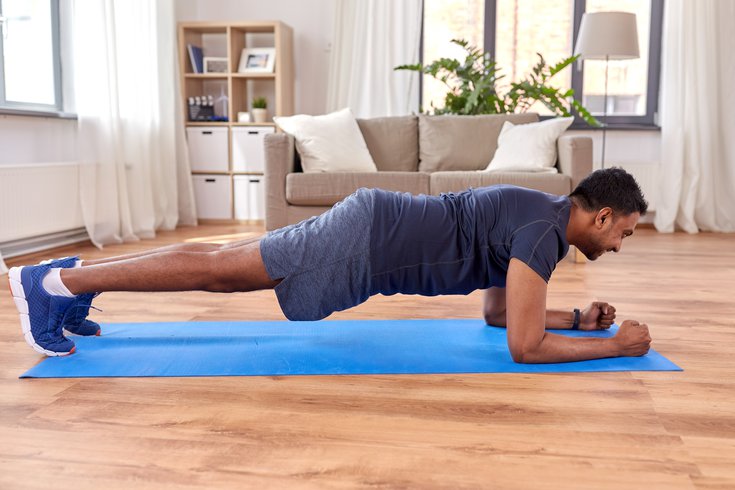
May 14, 2021
 Source/Image licensed from Ingram Image
Source/Image licensed from Ingram Image
Always keep a tight core when performing a plank. That means you should be flexing your core muscles the entire time, keeping your entire back straight and not dipping to the ground.
Everyone wants a strong core. The first thing I ask every new Drucker Fitness client is what their fitness goals are. To this day, I have never had a client who did not mention having "ripped abs" or a "strong core" as one of their main priorities for working out.
If you feel the same way, I hear you. I have always aimed to have a strong, toned core for both functional training purposes and, admittedly, for aesthetic reasons. I've gone into detail in the past about the importance of strengthening your core, as a strong core leads to proper squats and deadlifts, perfect push-ups and plays a huge role in pretty much every other exercise out there.
There are countless exercises you can do to strengthen your core, but today we are going to focus on a simple one: planks. For both myself and my clients, planks are an essential part of every workout and an absolute must for those looking to work the core.
At its core (see what I did there), a plank is an isometric core strengthening exercise that forces you to engage your entire body. An isometric exercise is an exercise without movement, which in this case means a static contraction of your abdominals and supporting muscles. Every single muscle in your body should be working when doing a plank, which is part of the reason why I love these so much.
What is so great about planks is that you need absolutely no equipment to perform one, so you are out of excuses! A favorite way of mine to get clients to add planks into their daily routines is to do them while watching TV. Every time there is a commercial break, drop down and hold a plank.
If you are like most of the country and binge watch shows on Netflix without commercials, no worries — I've got you covered. Set a timer for 15 minutes and every time it goes off, drop down and hold a 30-second plank. Repeat this for as long as you are watching TV. Hopefully it’s not five hours at a time, but hey, no judgment. If that is you, you are about to crush a ton of planks!
Another benefit of planks is that they are so versatile that you will never get bored of doing them. There are always ways to make planks harder and target specific muscles more intensely. There are low planks performed on your elbows, high planks on your hands, side planks performed on either the hands or elbows and even reverse planks, in which your body is belly up.
While all planks target the entire body and, more specifically, your trunk muscles, each plank has a different focus and it’s important to incorporate all of them into your workouts. High planks force you to engage your latissimus dorsi (lats) a bit more, whereas low planks recruit more core muscles to do the work. Side planks target your obliques while reverse planks target your posterior chain and triceps.
Whichever type of plank you are doing, there are a few key things to remember. First, always keep a tight core. This means you should be flexing your core muscles the entire time, keeping your entire back straight and not dipping to the ground.
A favorite cue of mine is to pretend you have a glass of water on your back while holding a plank. If you keep your entire body tight and in one line, the glass of water will stay upright. But when you let your hips sag, the glass will spill. Whether you are doing a high plank or a low plank, always make sure to keep your shoulders stacked over your wrists or your elbows, depending on the type of plank you are doing.
Another benefit of planks is that there are always modifications to be made if you feel a regular plank is too hard or your form is starting to be compromised. You always have the option to drop down to your knees and hold a plank. Similar to performing push-ups off your knees, you want to make sure your back is straight and your hips are slightly lifted.
To make planks harder, you can add in shoulder taps, hip dips and so much more. A favorite of mine is plank jacks, as they combine a classic plank with some additional cardio and coordination. To perform plank jacks, start in a basic elbow plank, then simultaneously jump both of your feet out wide and then jump them back into the starting position. This is a great way to challenge the core and your cardio!
No matter if you are starting from your knees or challenging yourself with plank jacks, you will always get in a killer core workout. Everyone starts somewhere, so grab a mat to protect your elbows, set your timer and get planking.
With beginners, I like to start with 30 seconds, even if that means half of the plank needs to be performed from the knees. If 30 seconds is too easy, up the time. Another fun way to make a basic plank harder is to make them weighted! Grab a weight plate or a heavy book and have a partner place it on your back. This will really challenge you!
Curious if you can handle a Drucker Fitness plank series? Check out this plank crusher and let me know how you do!